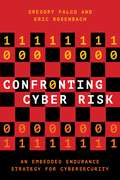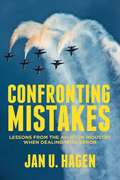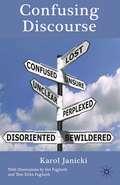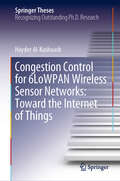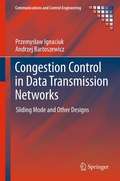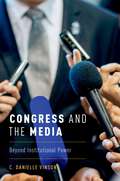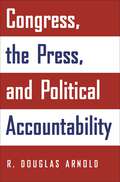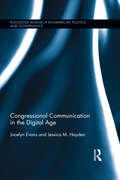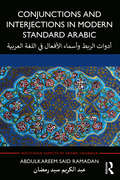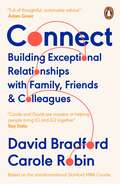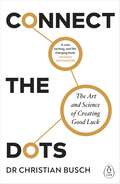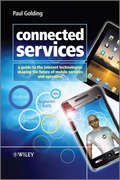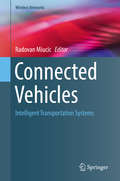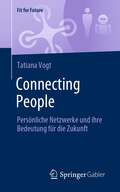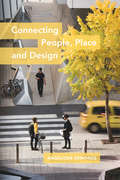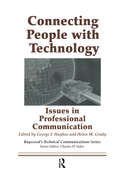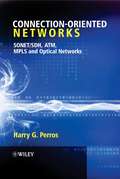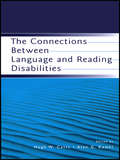- Table View
- List View
Confronting Cyber Risk: An Embedded Endurance Strategy for Cybersecurity
by Gregory J. Falco Eric RosenbachAn adaptive cyber risk management guide from MIT scientist and Johns Hopkins professor Gregory Falco and "Cyber Czar" Eric Rosenbach Cyberattacks continue to grow in number, intensity, and sophistication. While attackers persistently adapt, business leaders have suffered from employing the same cyber risk management strategies for decades. Organizations must learn how to move past temporary solutions and invest in long-term resiliency measures to thrive in the future cyber economy. Confronting Cyber Risk: An Embedded Endurance Strategy for Cybersecurity is a practical leadership guidebook outlining a new strategy for improving organizational cybersecurity and mitigating cyber risk. Veteran cybersecurity experts Falco and Rosenbach introduce the Embedded Endurance strategy as a systems-level approach to cyber risk management which addresses interdependent components of organizational risk and prepares organizations for the inevitability of cyber threats over the long-term. Using real world examples from SolarWinds to the Colonial Pipeline attack, the authors extend beyond hardware and software to provide a thoughtful ten-step process for organizations to address the simultaneous operational, reputational, and litigation risks common to cyberattacks. They conclude with helpful "cryptograms" from the future, in which business leaders are confronted with the next generation of cyber risk challenges. Clear and informative, Confronting Cyber Risk provides CEOs and cyber newcomers alike with concrete guidance on how to implement a cutting-edge strategy to mitigate an organization's overall risk to malicious cyberattacks in an evolving cyber risk landscape.
Confronting Cyber Risk: An Embedded Endurance Strategy for Cybersecurity
by Eric Rosenbach Gregory J. FalcoAn adaptive cyber risk management guide from MIT scientist and Johns Hopkins professor Gregory Falco and "Cyber Czar" Eric Rosenbach Cyberattacks continue to grow in number, intensity, and sophistication. While attackers persistently adapt, business leaders have suffered from employing the same cyber risk management strategies for decades. Organizations must learn how to move past temporary solutions and invest in long-term resiliency measures to thrive in the future cyber economy. Confronting Cyber Risk: An Embedded Endurance Strategy for Cybersecurity is a practical leadership guidebook outlining a new strategy for improving organizational cybersecurity and mitigating cyber risk. Veteran cybersecurity experts Falco and Rosenbach introduce the Embedded Endurance strategy as a systems-level approach to cyber risk management which addresses interdependent components of organizational risk and prepares organizations for the inevitability of cyber threats over the long-term. Using real world examples from SolarWinds to the Colonial Pipeline attack, the authors extend beyond hardware and software to provide a thoughtful ten-step process for organizations to address the simultaneous operational, reputational, and litigation risks common to cyberattacks. They conclude with helpful "cryptograms" from the future, in which business leaders are confronted with the next generation of cyber risk challenges. Clear and informative, Confronting Cyber Risk provides CEOs and cyber newcomers alike with concrete guidance on how to implement a cutting-edge strategy to mitigate an organization's overall risk to malicious cyberattacks in an evolving cyber risk landscape.
Confronting Mistakes: Lessons from the Aviation Industry when Dealing with Error
by J. HagenIn most organizations, errors - although common and unavoidable - are rarely mentioned bottom-up. Using this example of the high risk aviation industry this book assess how active error management can work and lead to success. Using academic research and 10 actual aviation accidents cases, this book will provide compelling and informative reading.
Confusing Discourse
by K. JanickiWe easily hear and see when people are talking and writing, but we often do not understand what they are talking or writing about . This book addresses some sources of confusion in discourse and offers suggestions for diminishing it.
Congestion Control for 6LoWPAN Wireless Sensor Networks: Toward the Internet of Things (Springer Theses)
by Hayder Al-KashoashThe Internet of Things (IoT) is the next big challenge for the research community. The IPv6 over low power wireless personal area network (6LoWPAN) protocol stack is considered a key part of the IoT. In 6LoWPAN networks, heavy network traffic causes congestion which significantly degrades network performance and impacts on quality of service aspects. This book presents a concrete, solid and logically ordered work on congestion control for 6LoWPAN networks as a step toward successful implementation of the IoT and supporting the IoT application requirements. The book addresses the congestion control issue in 6LoWPAN networks and presents a comprehensive literature review on congestion control for WSNs and 6LoWPAN networks. An extensive congestion analysis and assessment for 6LoWPAN networks is explored through analytical modelling, simulations and real experiments. A number of congestion control mechanisms and algorithms are proposed to mitigate and solve the congestion problem in 6LoWPAN networks by using and utilizing the non-cooperative game theory, multi-attribute decision making and network utility maximization framework. The proposed algorithms are aware of node priorities and application priorities to support the IoT application requirements and improve network performance in terms of throughput, end-to-end delay, energy consumption, number of lost packets and weighted fairness index.
Congestion Control in Data Transmission Networks: Sliding Mode and Other Designs (Communications and Control Engineering)
by Przemysław Ignaciuk Andrzej BartoszewiczCongestion Control in Data Transmission Networks details the modeling and control of data traffic in communication networks. It shows how various networking phenomena can be represented in a consistent mathematical framework suitable for rigorous formal analysis. The monograph differentiates between fluid-flow continuous-time traffic models, discrete-time processes with constant sampling rates, and sampled-data systems with variable discretization periods. The authors address a number of difficult real-life problems, such as: optimal control of flows with disparate, time-varying delay; the existence of source and channel nonlinearities; the balancing of quality of service and fairness requirements; and the incorporation of variable rate allocation policies. Appropriate control mechanisms which can handle congestion and guarantee high throughput in various traffic scenarios (with different networking phenomena being considered) are proposed. Systematic design procedures using sound control-theoretic foundations are adopted. Since robustness issues are of major concern in providing efficient data-flow regulation in today’s networks, sliding-mode control is selected as the principal technique to be applied in creating the control solutions. The controller derivation is given extensive analytical treatment and is supported with numerous realistic simulations. A comparison with existing solutions is also provided. The concepts applied are discussed in a number of illustrative examples, and supported by many figures, tables, and graphs walking the reader through the ideas and introducing their relevance in real networks. Academic researchers and graduate students working in computer networks and telecommunications and in control (especially time-delay systems and discrete-time optimal and sliding-mode control) will find this text a valuable assistance in ensuring smooth data-flow within communications networks.
Congress and the Media: Beyond Institutional Power
by C. Danielle VinsonOver the last four decades, members of Congress have increasingly embraced media relations as a way to influence national policymaking and politics. In 1977, nearly half of congressional members had no press secretary. Today, media relations is a central component of most congressional offices, and more of that communications effort is directed toward national media, not just the local press. Arguing that members of Congress turn to the media to enhance their formal powers or to compensate for their lack of power, Congress and the Media explains why congressional members go public and when they are likely to succeed in getting coverage. Vinson uses content analysis of national newspaper and television coverage of congressional members over time and members' messages on social media as well as case studies to examine how members in different political circumstances use the media to try to influence policymaking and how this has changed over time. She finds that members' institutional position, the political context, increasing partisan polarization, and journalists' evolving notions of what is newsworthy all affect which congressional members are interested in and successful in gaining media coverage of their messages and what they hope to accomplish by going public. Ultimately, Congress and the Media suggests that going public can be a way for members of Congress to move beyond their institutional powers, but the strategy is not equally available to all members nor effective for all goals.
CONGRESS & MEDIA BEYOND INSTITUT POWER C: Beyond Institutional Power
by C. Danielle VinsonOver the last four decades, members of Congress have increasingly embraced media relations as a way to influence national policymaking and politics. In 1977, nearly half of congressional members had no press secretary. Today, media relations is a central component of most congressional offices, and more of that communications effort is directed toward national media, not just the local press. Arguing that members of Congress turn to the media to enhance their formal powers or to compensate for their lack of power, Congress and the Media explains why congressional members go public and when they are likely to succeed in getting coverage. Vinson uses content analysis of national newspaper and television coverage of congressional members over time and members' messages on social media as well as case studies to examine how members in different political circumstances use the media to try to influence policymaking and how this has changed over time. She finds that members' institutional position, the political context, increasing partisan polarization, and journalists' evolving notions of what is newsworthy all affect which congressional members are interested in and successful in gaining media coverage of their messages and what they hope to accomplish by going public. Ultimately, Congress and the Media suggests that going public can be a way for members of Congress to move beyond their institutional powers, but the strategy is not equally available to all members nor effective for all goals.
Congress, the Press, and Political Accountability
by R. Douglas ArnoldCongress, the Press, and Political Accountability is the first large-scale examination of how local media outlets cover members of the United States Congress. Douglas Arnold asks: do local newspapers provide the information citizens need in order to hold representatives accountable for their actions in office? In contrast with previous studies, which largely focused on the campaign period, he tests various hypotheses about the causes and consequences of media coverage by exploring coverage during an entire congressional session. Using three samples of local newspapers from across the country, Arnold analyzes all coverage over a two-year period--every news story, editorial, opinion column, letter, and list. First he investigates how twenty-five newspapers covered twenty-five local representatives; and next, how competing newspapers in six cities covered their corresponding legislators. Examination of an even larger sample, sixty-seven newspapers and 187 representatives, shows why some newspapers cover legislators more thoroughly than do other papers. Arnold then links the coverage data with a large public opinion survey to show that the volume of coverage affects citizens' awareness of representatives and challengers. The results show enormous variation in coverage. Some newspapers cover legislators frequently, thoroughly, and accessibly. Others--some of them famous for their national coverage--largely ignore local representatives. The analysis also confirms that only those incumbents or challengers in the most competitive races, and those who command huge sums of money, receive extensive coverage.
Congress, the Press, and Political Accountability (PDF)
by R. Douglas ArnoldCongress, the Press, and Political Accountability is the first large-scale examination of how local media outlets cover members of the United States Congress. Douglas Arnold asks: do local newspapers provide the information citizens need in order to hold representatives accountable for their actions in office? In contrast with previous studies, which largely focused on the campaign period, he tests various hypotheses about the causes and consequences of media coverage by exploring coverage during an entire congressional session. Using three samples of local newspapers from across the country, Arnold analyzes all coverage over a two-year period--every news story, editorial, opinion column, letter, and list. First he investigates how twenty-five newspapers covered twenty-five local representatives; and next, how competing newspapers in six cities covered their corresponding legislators. Examination of an even larger sample, sixty-seven newspapers and 187 representatives, shows why some newspapers cover legislators more thoroughly than do other papers. Arnold then links the coverage data with a large public opinion survey to show that the volume of coverage affects citizens' awareness of representatives and challengers. The results show enormous variation in coverage. Some newspapers cover legislators frequently, thoroughly, and accessibly. Others--some of them famous for their national coverage--largely ignore local representatives. The analysis also confirms that only those incumbents or challengers in the most competitive races, and those who command huge sums of money, receive extensive coverage.
Congressional Communication in the Digital Age (Routledge Research in American Politics and Governance)
by Jocelyn Evans Jessica M. HaydenCommunication defines political representation. At the core of the representational relationship lies the interaction between principal and agent; the quality of this relationship is predicated upon the accessibility of effective channels of communication between the constituent and representative. Over the past decade, congressional websites have become the primary way constituents communicate with their members and a prominent place for members to communicate with constituents. Yet, as we move toward the third decade of the 21st century, little work has systematically analyzed this forum as a distinct representational space. In this book, Jocelyn Evans and Jessica Hayden offer a fresh, timely, and mixed-methods approach for understanding how the emergence of virtual offices has changed the representational relationship between constituents and members of Congress. Utilizing strong theoretical foundations, a broad historical perspective, elite interviews, and rich original datasets, Evans and Hayden present evidence that virtual offices operate as a distinct representational space, and they demonstrate that their use has resulted in unprecedented and ill-understood changes in representational behavior. Congressional Communication in the Digital Age contributes to the scholarship on representation theory and its application to the contemporary Congress. It is valuable reading for students and researchers interested in American politics, political communication, and legislative politics.
Congressional Communication in the Digital Age (Routledge Research in American Politics and Governance)
by Jocelyn Evans Jessica M. HaydenCommunication defines political representation. At the core of the representational relationship lies the interaction between principal and agent; the quality of this relationship is predicated upon the accessibility of effective channels of communication between the constituent and representative. Over the past decade, congressional websites have become the primary way constituents communicate with their members and a prominent place for members to communicate with constituents. Yet, as we move toward the third decade of the 21st century, little work has systematically analyzed this forum as a distinct representational space. In this book, Jocelyn Evans and Jessica Hayden offer a fresh, timely, and mixed-methods approach for understanding how the emergence of virtual offices has changed the representational relationship between constituents and members of Congress. Utilizing strong theoretical foundations, a broad historical perspective, elite interviews, and rich original datasets, Evans and Hayden present evidence that virtual offices operate as a distinct representational space, and they demonstrate that their use has resulted in unprecedented and ill-understood changes in representational behavior. Congressional Communication in the Digital Age contributes to the scholarship on representation theory and its application to the contemporary Congress. It is valuable reading for students and researchers interested in American politics, political communication, and legislative politics.
Conjunctions and Interjections in Modern Standard Arabic (Routledge Aspects of Arabic Grammar)
by Abdulkareem Said RamadanConjunctions and Interjections in Modern Standard Arabic is a grammar for Modern Standard Arabic introducing conjunctions and interjections from the most basic to the most advanced, with drills for each grammatical point. Skill in the use of conjunctions and interjections is essential for acquiring proficiency in expressing relationships of causation, order, time sequence and other relationships among events and ideas. Each chapter presents the grammar of conjunctions and interjections in clearly organized tables with examples of each use. An additional section presents multiple drills for practice and functional use. Aimed as a textbook for students for all four years of university Arabic, and for independent learners.
Connect: Building Exceptional Relationships with Family, Friends and Colleagues
by David L. Bradford Carole Robin'A practical and timely book' - Arianna Huffington, Founder and CEO, Thrive Global'Valuable for everyone' - Julia Samuel, bestselling authorBiting your tongue?Bottling it all up?From marriage to management challenges, learn how to change your relationships from exasperating to exceptional with this expert guide. The ability to create strong relationships with others is crucial to living a full life and becoming more effective at work. Yet many of us find ourselves struggling to build solid personal and professional connections, or unable to handle challenges that inevitably arise when we grow closer to others. When we find ourselves in an exceptional relationship -- the kind of relationship where we feel fully understood and supported for who we are -- it can seem like magic. But the truth is that the process of building and sustaining these relationships can be described, learned, and applied.David Bradford and Carole Robin taught interpersonal skills to MBA candidates for a combined seventy-five years in their legendary Stanford Graduate School of Business course Interpersonal Dynamics. Now, they share their insights with you, including:- Why relationship-building is not the process of being with 'the right person' but rather creating the kind of relationship you want- Why deepening a relationship takes risk- The importance of vulnerability, curiosity and empathy in building relationships- How the modern world can help - and hinder - our ability to connectFilled with time-tested strategies for giving feedback, negotiating boundaries, and working through disagreements, Connect will be an important resource for anyone hoping to improve existing relationships and build new ones at any stage of life.
Connect the Dots: The Art and Science of Creating Good Luck
by Dr Christian BuschWhat if being lucky wasn't just chance but a skill you could master? Learn to identify and act on serendipity to lead a more joyful, purposeful, and successful life! 'A wise, exciting and life-changing book' Arianna Huffington, author of Thrive ___________________________________________Modern life is full of chance encounters, changing plans, delayed journeys, human errors and other mishaps. This is the hidden force that rules our universe: serendipity. But what if we could use such unpredictability to our advantage?Dr Christian Busch has spent a decade exploring how, if acted upon, unexpected encounters can enhance our worldview, expand our social circles and create new professional opportunities. From couples who met during chance encounters to businesspeople who invented world-changing ideas after a misfire, Dr Busch has studied hundreds of subjects who improved their lives by learning to see opportunities in the unexpected. Connect the Dots is a revolutionary, well-researched exploration of an essential life skill that we can all develop and master. ___________________________________________ 'Busch shows convincingly that it's more than blind luck in Connect the Dots, which offers excellent practical guidance for all' Paul Polman, former CEO of Unilever and co-founder of Imagine'Christian Busch reveals that luck isn't always dumb' Daniel H. Pink, bestselling author of When and Drive 'More than just a way to create exciting opportunities, it's the foundation for a more optimistic and meaningful life. An important book for a complicated world' Cal Newport, author of Digital Minimalism*Previously published as The Serendipity Mindset*
Connected Services: A Guide to the Internet Technologies Shaping the Future of Mobile Services and Operators
by Paul Golding"Connected Services is a must-read for telco strategists who need to get up to speed on how the world of software and the web 2. 0 works." Andreas Constantinou, Research Director, VisionMobile "This book is a must read for those charged with leading innovation in a world of connected services where telco and Internet collide." - Jason Goecke, VP of Innovation, Voxeo Labs This book explains the common underlying technological themes that underpin the new era of connected services in a post Web 2.0 epoch In this book, the author explores the underlying technological themes that underpin the new era of connected services. Furthermore, it explains how the technologies work and what makes each of them significant, for example, the potential for finding new meaning in data in the world of BIG DATA platforms, often referred to as “No-SQL” databases. In addition, it tackles the newest areas of technology such as HTML5, Android, iOS, open source, mash-ups, cloud computing, real-time Web, augmented reality, and more. Finally, the book discusses the opportunities and challenges of a connected world where both machines and people communicate in a pervasive fashion, looking beyond the hype and promise of emerging categories of communication such as the “Internet of Things” and “Real-time Web” to show managers how to understand the potential of the enabling technologies and apply them for meaningful applications in their own world. Key Features: Explores the common and emergent underlying technological themes that underpin the new era of connected services Addresses the newest areas of Internet technology such as web and mobile 2.0, open source, mash-ups, cloud computing, web 3.0, augmented reality, and more Shows the reader how to understand the potential of the enabling technologies and apply them for meaningful applications in their own world Discusses new developments in the technological landscape such as Smartphone proliferation, maturation of Web 2.0, increased convergence between mobile networks and the Internet, and so forth Examines modern software paradigms like Software-as-as-Service (SaaS), Platform-as-a-Service (PaaS) and Network-as-a-Service (NaaS) Explores in detail how Web start-ups really work and what telcos can do to adopt lean and agile methods This book will be an invaluable guide for technical designers and managers, project managers, product managers, CEOs etc. at mobile operators (O2, Vodafone, Orange, T-Mobile, BT), fixed operators, converged operators and their contributory supplier networks (e.g. infrastructure providers). Internet providers (Google, Yahoo, Amazon, eBay, Apple, Facebook), analysts, product managers, developers, architects, consultants, technology investors, analysts, marketing directors, business development directors will also find this book of interest.
Connected Services: A Guide to the Internet Technologies Shaping the Future of Mobile Services and Operators
by Paul Golding"Connected Services is a must-read for telco strategists who need to get up to speed on how the world of software and the web 2. 0 works." Andreas Constantinou, Research Director, VisionMobile "This book is a must read for those charged with leading innovation in a world of connected services where telco and Internet collide." - Jason Goecke, VP of Innovation, Voxeo Labs This book explains the common underlying technological themes that underpin the new era of connected services in a post Web 2.0 epoch In this book, the author explores the underlying technological themes that underpin the new era of connected services. Furthermore, it explains how the technologies work and what makes each of them significant, for example, the potential for finding new meaning in data in the world of BIG DATA platforms, often referred to as “No-SQL” databases. In addition, it tackles the newest areas of technology such as HTML5, Android, iOS, open source, mash-ups, cloud computing, real-time Web, augmented reality, and more. Finally, the book discusses the opportunities and challenges of a connected world where both machines and people communicate in a pervasive fashion, looking beyond the hype and promise of emerging categories of communication such as the “Internet of Things” and “Real-time Web” to show managers how to understand the potential of the enabling technologies and apply them for meaningful applications in their own world. Key Features: Explores the common and emergent underlying technological themes that underpin the new era of connected services Addresses the newest areas of Internet technology such as web and mobile 2.0, open source, mash-ups, cloud computing, web 3.0, augmented reality, and more Shows the reader how to understand the potential of the enabling technologies and apply them for meaningful applications in their own world Discusses new developments in the technological landscape such as Smartphone proliferation, maturation of Web 2.0, increased convergence between mobile networks and the Internet, and so forth Examines modern software paradigms like Software-as-as-Service (SaaS), Platform-as-a-Service (PaaS) and Network-as-a-Service (NaaS) Explores in detail how Web start-ups really work and what telcos can do to adopt lean and agile methods This book will be an invaluable guide for technical designers and managers, project managers, product managers, CEOs etc. at mobile operators (O2, Vodafone, Orange, T-Mobile, BT), fixed operators, converged operators and their contributory supplier networks (e.g. infrastructure providers). Internet providers (Google, Yahoo, Amazon, eBay, Apple, Facebook), analysts, product managers, developers, architects, consultants, technology investors, analysts, marketing directors, business development directors will also find this book of interest.
Connected Vehicles: Intelligent Transportation Systems (Wireless Networks)
by Radovan MiucicThis book introduces concepts and technologies of Intelligent Transportation Systems (ITS). It describes state of the art safety communication protocol called Dedicated Short Range Communication (DSRC), currently being considered for adoption by the USDOT and automotive industry in the US. However, the principles of this book are applicable even if the underlying physical layer protocol of V2X changes in the future, e.g. V2X changes from DSRC to cellular-based connectivity. Fundamental ITS concepts include topics like global positioning system; Vehicle to Vehicle (V2V), Vehicle to Pedestrian (V2P), and Vehicle to Infrastructure (V2I) communications; human-machine interface; and security and privacy. Fundamental concepts are sometimes followed by the real-life test experimental results (such as in V2P Chapter) and description of the performance metrics used to evaluate the results. This book also describes equations and math used in the development of the individual parts of the system. This book surveys current and previous publications for trending research in the ITS domain. It also covers state of the art standards that are in place for the DSRC in the US, starting from the application layer defined in SAE J2735 all the way to physical layer defined in IEEE 802.11. The authors provide a detailed discussion on what is needed to extend the current standards to accommodate future needs of the vehicle communications, such as needs for future autonomous vehicles. Programs and code examples accompany appropriate chapters, for example, after describing remote vehicle target classification function a pseudo code and description is provided. In addition, the book discusses current topics of the technology such as spectrum sharing, simulation, security, and privacy. The intended audience for this book includes engineering graduate students, automotive professionals/engineers, researchers and technology enthusiasts.
Connecting People: Persönliche Netzwerke und ihre Bedeutung für die Zukunft (Fit for Future)
by Tatiana VogtNetzwerken ist so alt wie die Menschheit selbst. Es schenkt uns Verbindung, ein Gefühl von Zusammengehörigkeit, schafft einen sozialen und gesellschaftlichen Rahmen, der unser Gefüge zusammenhält und das eigene Überleben sichert. Das Zusammenwirken fördert unsere Entwicklung und schafft einen Verbund und Austausch von Interessen, in allen Bereichen unseres Lebens. Der Mensch ist nun einmal ein soziales Wesen, das Nähe, Kontakt, Austausch sucht und braucht. Doch wie netzwerkt man miteinander, gerade in einer sich stetig wandelnden Welt? Im Zeitalter der Digitalisierung werden persönliche Kontakte immer seltener und rücken in den Hintergrund. Roboter Netzwerke entstehen und ersetzen in vielen Fällen berufsbedingt den Menschen. Doch gerade hier liegt auch eine Chance, denn durch das aktive Netzwerken können sich Menschen im beruflichen und privaten Kontext von der Maschine abheben.
Connecting People, Place and Design
by Angelique EdmondsConnecting People, Place and Design examines the human relationship with place, how its significance has evolved over time and how contemporary systems for participation shape the places around us. This volume examines people, place and design across architecture, design, cultural studies, sociology, political science and philosophy.
Connecting People with Technology: Issues in Professional Communication (Baywood's Technical Communications)
by George F. HayhoeThis book explores five important areas where technology affects society, and suggests ways in which human communication can facilitate the use of that technology.Usability has become a foundational discipline in technical and professional communication that grows out of our rhetorical roots, which emphasize purpose and audience. As our appreciation of audience has grown beyond engineers and scientists to lay users of technology, our appreciation of the diversity of those audiences in terms of age, geography, and other factors has similarly expanded.We are also coming to grips with what Thomas Friedman calls the 'flat world,' a paradigm that influences how we communicate with members of other cultures and speakers of other languages. And because most of the flatteners are either technologies themselves or technology-driven, technical and professional communicators need to leverage these technologies to serve global audiences.Similarly, we are inundated with information about world crises involving health and safety issues. These crises are driven by the effects of terrorism, the aging population, HIV/AIDS, and both human-made and natural disasters. These issues are becoming more visible because they are literally matters of life and death. Furthermore, they are of special concern to audiences that technical and professional communicators have little experience targeting - the shapers of public policy, seniors, adolescents, and those affected by disaster.Biotechnology is another area that has provided new roles for technical and professional communicators. We are only beginning to understand how to communicate the science accurately without either deceiving or panicking our audience. We need to develop a more sophisticated understanding of how communication can shape reactions to biotechnology developments. Confronting this complex network of issues, we're challenged to fashion both our message and the audience's perceptions ethically.Finally, today's corporate environment is being shaped by technology and the global nature of business. Technical and professional communicators can play a role in capturing and managing knowledge, in using technology effectively in the virtual workplace, and in understanding how language shapes organizational culture.
Connecting People with Technology: Issues in Professional Communication (Baywood's Technical Communications)
by George Hayhoe Helen M. M. GradyThis book explores five important areas where technology affects society, and suggests ways in which human communication can facilitate the use of that technology.Usability has become a foundational discipline in technical and professional communication that grows out of our rhetorical roots, which emphasize purpose and audience. As our appreciation of audience has grown beyond engineers and scientists to lay users of technology, our appreciation of the diversity of those audiences in terms of age, geography, and other factors has similarly expanded.We are also coming to grips with what Thomas Friedman calls the 'flat world,' a paradigm that influences how we communicate with members of other cultures and speakers of other languages. And because most of the flatteners are either technologies themselves or technology-driven, technical and professional communicators need to leverage these technologies to serve global audiences.Similarly, we are inundated with information about world crises involving health and safety issues. These crises are driven by the effects of terrorism, the aging population, HIV/AIDS, and both human-made and natural disasters. These issues are becoming more visible because they are literally matters of life and death. Furthermore, they are of special concern to audiences that technical and professional communicators have little experience targeting - the shapers of public policy, seniors, adolescents, and those affected by disaster.Biotechnology is another area that has provided new roles for technical and professional communicators. We are only beginning to understand how to communicate the science accurately without either deceiving or panicking our audience. We need to develop a more sophisticated understanding of how communication can shape reactions to biotechnology developments. Confronting this complex network of issues, we're challenged to fashion both our message and the audience's perceptions ethically.Finally, today's corporate environment is being shaped by technology and the global nature of business. Technical and professional communicators can play a role in capturing and managing knowledge, in using technology effectively in the virtual workplace, and in understanding how language shapes organizational culture.
Connection-Oriented Networks: SONET/SDH, ATM, MPLS and Optical Networks
by Harry G. PerrosA thorough knowledge of modern connection-oriented networks is essential to understanding the current and near-future state of networking. This book provides a complete overview of connection-oriented networks, discussing both packet-switched and circuit-switched networks, which, though seemingly different, share common networking principles. It details the history and development of such networks, and defines their terminology and architecture, before progressing to aspects such as signaling and standards. There is inclusive coverage of SONET/SDH, ATM networks, Multi-Protocol Label Switching (MPLS), optical networks, access networks and voice over ATM and MPLS. Connection-oriented Networks: * Provides in-depth, systematic coverage of several connection-oriented networks in a single volume * Explains topics such as the Generic Framing Procedure, Label Distribution Protocols, Wavelength Routing Optical Networks, Optical Burst Switching, and Access Networks in detail * Illustrates all concepts with problems and simulation projects to test and deepen your understanding * Includes an accompanying website with solutions manual and complete set of PowerPoint presentations for each chapter Senior undergraduate and graduate students in telecommunication and networking courses, as well as networking engineers, will find this comprehensive guide to connection-oriented packet-switched and circuit-switched networks useful for their training. The book presents tried and tested material based on an existing, successful course.
The Connections Between Language and Reading Disabilities
by Hugh W. Catts Alan G. KamhiThis is an edited book based on papers presented at a 2003 invitee-only conference under the sponsorship of the Merrill Advanced Studies Center of the University of Kansas. The participants were prominent scholars in the areas of language and reading, and have research programs funded by NIH and other sources. The purpose of the gathering was to discuss theoretical issues and research findings concerning the relationship between developmental language and reading disabilities, specifically looking at neurological, behavioral, and genetic factors. In addition, it discussed other factors contributing to reading difficulties in the middle elementary school years through adolescence and literacy outcomes for children with early language impairments, and how these problems relate to children with dyslexia. The Foreword is written by Reid Lyon, Branch Chief, Child Development and Behavior Branch, NICHD-National Institutes of Health.This book appeals to scholars in the areas of language disorders and reading disabilities, as well as to practicing speech-language pathologists, special educators, and reading specialists. It may also be used in graduate courses designed as seminars in either language disorders or reading disabilities in schools of communication disorders, as well as schools of education--especially special education departments.
The Connections Between Language and Reading Disabilities
by Hugh W. Catts Alan G. KamhiThis is an edited book based on papers presented at a 2003 invitee-only conference under the sponsorship of the Merrill Advanced Studies Center of the University of Kansas. The participants were prominent scholars in the areas of language and reading, and have research programs funded by NIH and other sources. The purpose of the gathering was to discuss theoretical issues and research findings concerning the relationship between developmental language and reading disabilities, specifically looking at neurological, behavioral, and genetic factors. In addition, it discussed other factors contributing to reading difficulties in the middle elementary school years through adolescence and literacy outcomes for children with early language impairments, and how these problems relate to children with dyslexia. The Foreword is written by Reid Lyon, Branch Chief, Child Development and Behavior Branch, NICHD-National Institutes of Health.This book appeals to scholars in the areas of language disorders and reading disabilities, as well as to practicing speech-language pathologists, special educators, and reading specialists. It may also be used in graduate courses designed as seminars in either language disorders or reading disabilities in schools of communication disorders, as well as schools of education--especially special education departments.
